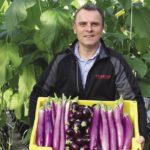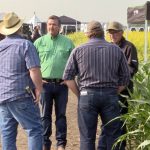Glacier FarmMedia – The growing number of new crop automation products coming to market are finding their first uses in high-value crops, like vegetables or grapes. Several farm robots featured at the recent AgRobotics and Automation event hosted by the RH Accelerator focused on higher-value crops instead of corn, soybeans or wheat. The interest is[...]


Farm opportunities on your mind
Not so long ago, all the buzz was about unleashing Canada’s full agricultural potential on a world that desperately needs our farmers to produce more and more. Global population was booming, more countries were more prosperous, and consumers everywhere were changing and improving their diets. Now our country needs Canada’s farmers to succeed too. Whether[...]

Into the future
While it’s not exactly as futuristic as 2001: A Space Odyssey, it’s no longer such a big stretch to imagine the day when a single operator anywhere in the world can remotely control 25 to 30 tractors, and when our crops effectively send us emails letting us know what they need. As professor and chair[...]

Regenerative agriculture hits the mainstream
If you’re a cattle producer, you may already have heard the term “regenerative agriculture.” If you’re a grain producer, maybe not. But that’s about to change. This spring, General Mills announced a plan to advance regenerative agriculture practices on one million acres of farmland in the U.S. and Canada by 2030, and Cargill Canada announced[...]

Where are investments in Canadian agricultural research headed?
“Sunny today but with clouds on the horizon” is how Serge Buy describes Canadian government investment in agricultural research. “There was more willingness for the federal government to invest in budgets 2016 and 2017, and some of the provinces are following suit,” says Buy, who’s the CEO of the Agricultural Institute of Canada (AIC). “That’s[...]

The news on soil health
Don Lobb takes a very dim view of how mankind has treated soil over the millennia, but he is slightly more hopeful for this generation, due both to our constantly growing body of knowledge about soils, and to farmers who are not only willing to experiment with better ways to take care of the soil,[...]

Putting down roots in Canadian soil
Before we even exchange our first word, I get a sense of Raymond Ngarboui. When we meet, he’s on the phone with a refugee settlement counsellor who asks if he might have garden plots available for two families from Burundi, recently arrived in Winnipeg and feeling stressed and isolated. This is 43-year-old Ngarboui’s side-project but[...]

Growing soybeans in southern Alberta
For some Prairie farmers, the question of whether to introduce soybeans into the rotation may seem like a no-brainer. They’re good nitrogen fixers and have proven a hit on rain-fed land in Manitoba and Saskatchewan, where soybean acreage has increased dramatically over the past decade. But if you’re a producer in Alberta, the answer is[...]

Making ethnic markets pay
Edamame, okra, bitter melon, quinoa, Chinese long eggplant — all these are edible crops that you’d have had a hard time finding on the country’s store shelves 50 years ago, let alone growing in Canadian fields and greenhouses. They’re still crops that few Canadian farmers know about, and that even fewer have considered growing. But[...]

Interest in biological crop inputs continues to grow
It was only a few years ago that interest in alternative methods such as biologicals to boost a crop’s nutrient uptake seemed to spike in popularity. But according to Spencer Harris, senior vice-president of global ag retail for Nutrien Ag Solutions, biologicals are not all that new for Nutrien — the global ag retailer has been researching biological crop inputs for nearly two decades.


